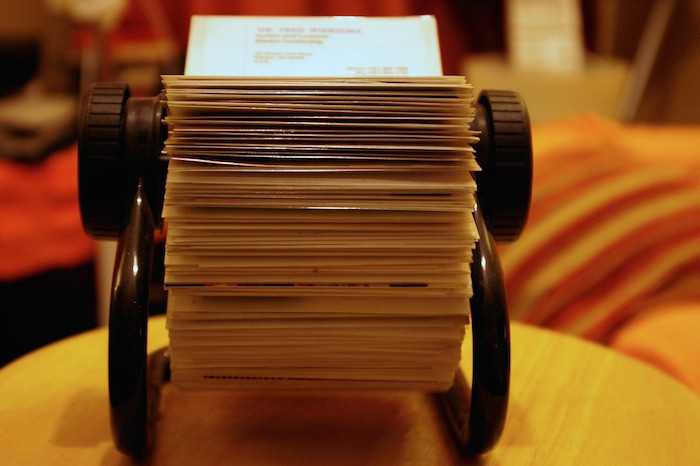
Like many tools that end up in use in newsrooms, Rolodex — a new directory and discovery tool built at The Dallas Morning News — started out as a hobby project.
Jon McClure, a news apps developer, was tinkering around with the Neo4j graphing tool in his spare time, exploring how to visualize networks of people. He quickly realized the best way to put his ideas into practice would be to build a database of sources for the paper.
What he came up with was Rolodex, an open source tool that lets reporters contribute to a newsroom system of contacts. But the app can also serve as the backend to news apps that surface contact information or show the strength of networks. Think of it like this: Morning News reporters can use Rolodex to create a database of emails and phone number for, say, records officials across Dallas County — but they can also show how those people and organizations are interconnected.
“We all know what it’s like in newsrooms where every couple of years someone says, ‘Let’s update our master source list,’ and we try to get things together,” said Dave Hiott, deputy projects editor for the Morning news. “It never lasts.”
 That difficultly stems from reporter reluctance — are you really going to share the cell of that deputy chief with everyone? — but also a lack of accessible, easy-to-use tools. Many newsrooms have master lists of sources, but they’re often buried in an intranet, on a shared drive, or in some other archaic system.
That difficultly stems from reporter reluctance — are you really going to share the cell of that deputy chief with everyone? — but also a lack of accessible, easy-to-use tools. Many newsrooms have master lists of sources, but they’re often buried in an intranet, on a shared drive, or in some other archaic system.
Right now, only a small group of reporters use Rolodex, Hiott said — the idea is to slowly give more people a chance to use the tool and see how it might help their reporting. Specifically, Hiott said Rolodex would be useful in longterm investigations where you have to map sources, as well as in breaking news situations when you’re trying to find anyone to talk to at specific businesses or agencies.
“We don’t want to send a note out to the newsroom to say everyone must use this now — you know how journalists may react to that,” Hiott joked.
This is a issue developers and others inside newsrooms have been trying to rectify for some time: How do you capture the accumulated knowledge of reporters outside the stories they publish? For some organizations, the answer is turning reporting into durable news apps that can refresh data on a regular basis.“This is a large dataset that goes to waste in people’s notebooks all the time,” McClure said. “The sell to editors and management here is there’s a lot of turnover in our industry and we can lose a lot of contacts when people go.”
The app has two functions that are interconnected. As they explain on the GitHub page:
The stand-alone app provides a clean, intuitive interface for our reporters to enter and search basic information about people and orgs and the relationships between them, while the API and Django plugin lets us cut out quick graphs of related entities.
Rolodex served as the basis for backend for On The Record, a news app launched in February designed to simplify public records requests from local government agencies. Similar in spirit to projects like MuckRock or FOIA Machine, On The Record’s usefulness comes from the near-automated nature of making a request and the ability to track the progress of the records.
In order for that process to work, On The Record relies on a database of contact information across institutions, ranging from Texas A&M University to the City of Plano to the Dallas Independent School District. In order to launch the project, reporters seeded the database with contacts from 150 agencies, but users can also help expand the database by entering any contact info they may have for officials or suggesting agencies that should be listed.
McClure said they plan to roll out Rolodex gradually to other desks in the newsroom, with reporters gradually adding sources to the list to help build a broader database. (One issue: Rolodex still requires manual input for new contacts.) Part of the pitch to reporters: “Input the contacts as you see them and it makes it easier for you to not get midnight phone calls about ‘hey, how do we get in touch with this person,'” he said.
McClure said their goal is to continue developing products that will make the work of the newsroom easier and build datasets that could be useful in the future. “In a lot of ways, we want to mashup important data capture we think should be happening with tools that cater to people’s productivity needs,” he said.